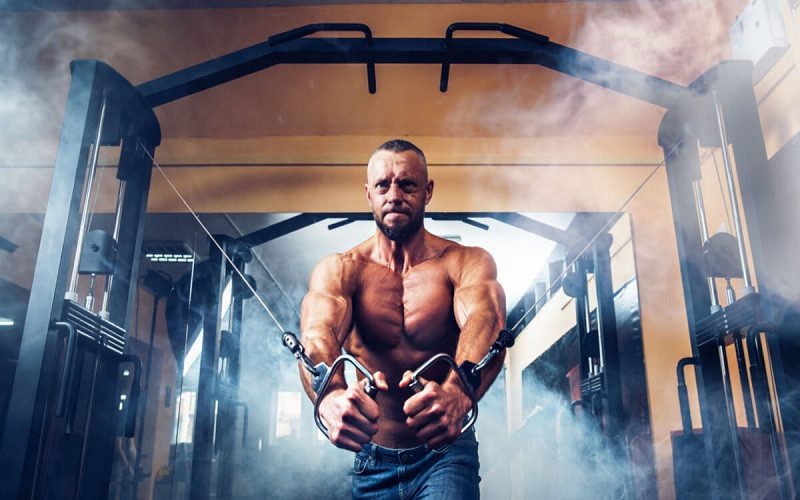14 Best Cable Chest Exercises and Workout Routines

Take your chest workout routine to the next level with cable chest exercises.
A cable chest exercise targets your chest muscles with constant tension throughout the exercise and a full range of motion.
One of the most important qualities of a good physique is a well-shaped chest.
Your chest needs to be trained with a variety of exercises to develop the upper and lower pectorals, the inside and outside pectorals, and the entire rib cage.
By training the chest at different angles, the cable chest workout helps strengthen the chest.
We will discuss the following topics in this blog:
- Chest Anatomy
- Best Cable Chest Exercises
- How to do it, and pro-tips.
- Common mistakes to be avoided.
Learn More About Chest Muscles
Pectoralis major and pectoralis minor are chest muscles.
Depending on the angle of adduction, the pectoralis major consists of two heads:
- Upward movement emphasizes the upper pec or clavicular head,
- An angle lower than 45 degrees emphasizes the lower pec, or sternal head.
Under the pectoralis major is the triangle-shaped pectoralis minor, which pulls the shoulder blades down and forward.

Cable Chest Workout
The cable chest exercise uses a cable machine to train the chest muscles.
With cable chest exercises, constant tension is created on the chest muscles throughout the entire range of motion using a cable pulley system.
Chest muscles can be strengthened, enlarged, and defined by this tension.
In addition to being versatile and effective, cable chest exercises can also be easily modified by adjusting the weight, angle of the pulleys, and attachments.
Types Of Chest Cable Exercises
Cable machines can be used to perform several types of chest exercises.
- Cable Flyes
- Cable Crossovers
- Cable Chest Press
- Pullovers
Through the entire range of motion, each exercise provides constant tension on the chest muscles.
Multijoint exercises, such as press exercises, focus primarily on the chest muscle, but also train the deltoid and tricep muscles.
The Cable Flye targets the chest muscles from a different angle. This exercise can be performed with both arms simultaneously or one arm at a time to isolate the chest muscles further.
A cable crossover is similar to a flye, but the cables are crossed in front of the body. This exercise can be done standing, kneeling, or with one arm at a time.
Benefits Of The Cable Chest Exercises
The following are the main benefits of using cables for chest exercises:
Joint Friendly
Cable chest exercises are a great alternative for people who have joint discomfort when doing bench presses.
A cable with proper shoulder-blade stability changes the angle of the movement enough to limit joint stress.
Provide Constant Tension
Cable exercises are more evenly distributed, and you have a constant load on your chest muscles throughout the whole range of motion, which makes them better than free weights.
A greater range of motion
Compared to traditional chest exercises, cable exercises allow for greater range of motion, improving flexibility and mobility.
Motion That Is Smooth And Controlled
Cable machine workouts provide a smooth, controlled motion that can be customized by the variables above.
Targeted Muscle Activation
By varying the position of the body and the direction of the cable, you can work out different parts of the pectoral muscles.
Assists in creating a more balanced and defined chest by including the upper, middle, and lower chest.
Versatility
In addition to being versatile and effective, cable chest exercises can be easily modified by adjusting the weight, angle, and attachments.
Muscle growth is a hallmark of this product
A cable setup gives your muscles almost uninterrupted tension and a huge pump, both of which can enhance muscle growth.
Using a cable machine to build a chest
Chest cable exercises are great for strengthening your pectoralis major, which makes up the majority of your chest.
With the cable machine, you can target all pecs muscles from different angles.
By changing body positioning, weight load, and attachments used, you can alter your grip, thus targeting your muscles differently.
By manipulating angles and changing attachments, the cable crossover machine can be used for a wide variety of chest exercises.
With cable chest exercises, your muscles will be under constant tension for a long period of time, resulting in more muscle growth. You can use a cable machine to perform chest presses and flys with free weights from a standing, sitting, and lying position.
Exercises for the chest with a cable machine
Presses and flyes are the two main chest exercises you'll do with cables. However, there are many variations for both exercises.
Here are the best cable chest exercises to build a bigger and wider chest.
Combined with cable chest workouts, you will be able to target each and every muscle fiber in your chest.
Middle Cable Fly (Cable Crossover)
To build massive pecs, cable crossover is a great exercise to add to your routine. It provides constant tension in building massive pecs.
A standing cable crossover exercise develops and defines the lower and inner pectoral muscles.
By providing the much-needed stress in the lower and inner pecs, cables provide constant resistance and aid in the development of the lower and central chest muscles.

Muscles Worked
Pectoralis is the primary muscle.
The secondary muscles are the anterior deltoid, latissimus dorsi (back), biceps brachii, and rhomboids (back).
How To Do
- Hold both handles of overhead pulleys in a standing position.
- Feel your chest muscles being stretched as you bend forward and extend your arms.
- Get a good chest contraction by flexing your arms with elbows slightly bent.
- Pecs can be contracted fully by crossing the center, unlike chest flies.
Tips
- When relaxing, breathe in, and when contracting, keep your head up.
- At the end of the movement, squeeze your chest.
Low Cable Fly
Standing low to high cable fly provides constant tension, helping build upper pec muscles while strengthening the pushing muscles of the body, including the chest, biceps, and shoulders.
The Low to High Cable Fly exercise develops and defines the upper and inner pectoral muscles.

Muscles Worked
Upper pectoralis is the primary muscle
The anterior deltoid and the biceps brachii are secondary muscles
How To Do
- Grab both handles of overhead pulleys on both sides and lower both pulleys to the desired weight.
- Feel your chest muscles stretch as you bend slightly forward and extend your arms.
- Pull your hands toward each other in wide arcs in front of you, pausing when your hands touch.
- Repeat for the desired number of repetitions before slowly lowering back to the starting position.
Tips
- Stand staggered to keep your balance.
- Lift the handles up and together while exhaling.
- As you lower your arms, control the weight.
High Cable Fly
This exercise targets the lower portion of your chest and is a variation of the chest fly.
A high-to-low cable fly is a machine exercise that primarily targets the chest, but also targets the shoulders and triceps to a lesser extent.

Muscles Worked
Primary: Lower pectoralis
Anterior deltoid, latissimus dorsi (back), biceps brachii, rhomboids are secondary muscles.
How To Do
- Grab the handles with a neutral grip, set both pulleys as high as possible, and select the desired weight.
- Feel your chest muscles stretching as you bend forward and extend your arms.
- In wide arcs in front of you, bend your elbows slightly, and pull your hands (high to low) toward each other.
- Repeat for the desired number of repetitions by slowly lowering back to the starting position.
Tips
- Maintain some tension in your abs and avoid arching your lower back too much.
- Choosing a heavy weight should be based on form.
- Pull the handles together while exhaling.
Cable chest press while standing
Standing cable chest presses are another great exercise for your cable chest workout, as they increase the range of motion where your hands meet compared to conventional bench presses.
By controlling every angle the weight can move in, the standing bench press engages your core and stabilizer muscles far more.

Muscles Worked
Primary: Pectoralis.
Secondary: lateral deltoid, latissimus dorsi (back), biceps brachii, rhomboids (back).
How To Do
- Grip the stirrups on both sides while standing in the middle of the two pulleys.
- With one leg in front of the other, step forward a couple of feet in front of the cable machine.
- By extending your elbows, move the handles forward until your hands meet in the middle.
- Slowly return to the starting position after briefly squeezing.
Tips
- Keep your head up, your core engaged, and the rest of your body stationary.
- When relaxing, breathe in and out, keeping your head up at all times.
- At the end of the movement, squeeze your chest.
Bench press with cable flat
The lying cable chest press allows the user to perform a flat bench press without the need for a spotter.
As a result of the cable pulleys' strength curve being more closely aligned with the movement/muscle, cable chest presses involve a greater amount of constant tension than most traditional free-weight chest presses.

Muscles Worked
Primary: Pectoralis
The anterior deltoid, triceps, and biceps brachii are secondary muscles
How To Do
- Place your feet flat on the floor and attach stirrup handles to the low pulleys.
- You should hold the cable directly over your middle chest with your arms straight up from your shoulders.
- Keeping your arms slightly bent, slowly lower the cable attachments outward to your sides until your arms are parallel to the ground,
- Use your pecs muscles to pull your arms back together as you draw them towards the midline of your body. Repeat as many repetitions as you like.
Tips
- During the negative phase of the exercise, do not overextend.
- When your hands are together, contract your chest muscles.
- To protect your shoulder joint, keep your arms bent.
Bench Press with Cable Incline
At the top of dumbbell incline bench presses, your triceps brachii take over much of the force from your chest.
The incline cable bench press, however, focuses more on your upper pectoralis major throughout because the resistance originates from an angle and you have to pull the stirrups inward at the end of the movement.

Muscles Worked
The upper pectoralis major is the primary muscle
Anterior deltoid, triceps, and biceps brachii
How To Do
- Attach stirrup handles to the low pulleys and lie down on the bench with your feet flat on the ground. Set the bench at a 30- to 45-degree angle.
- Exhale as you extend your elbows up and move your arms up and inward.
- As you slowly release back to the starting position, squeeze your chest at the top of the movement.
- As many repetitions as you like.
Tips
- You can vary the position of the bench to hit the upper chest from different angles.
- When your hands are together, contract your chest muscles.
- It is best to set the bench at an angle of 30-45 degrees. If you go more upright, the stress is shifted to the shoulders rather than the chest.
Bench Press with Cable Decline
Decline dumbbell bench presses are variations of decline cable chest presses.
Decline cable presses are great exercises for the chest, shoulders, and triceps.
By using cables, as seen in the decline cable chest press, one can maintain constant tension throughout the exercise.

Muscles Worked
Lower pectoralis is the primary muscle.
The anterior deltoid and triceps are secondary muscles.
How To Do
- Place your feet flat on the foot pad or roller of a Decline bench set at a 30-degree angle.
- Hold the cable handle over your chest with your arms straight up from your shoulders.
- When you are in position, slowly extend your arms straight out until you feel tension in your chest, and hold for a count of three.
- Using your lower pecs muscles, draw your arms back toward your midline.
Tips
- Not completely locking out the elbows will help maintain more tension through the pecs.
- Changing the position of the bench will allow you to hit the lower chest from different angles.
- When your hands are together, contract your chest muscles.
- The bench should be set at about a 30 degree decline.
Flying Cable Chest
In the Pectoralis Major (Chest), lying cable fly builds muscle and strength.
When training the chest, cables are an excellent tool for maintaining tension on the chest muscle.

Muscles Worked
Primary: Pectoralis
The anterior deltoid, triceps, and biceps brachii are the secondary muscles
How To Do
- Place your feet flat on the floor and attach stirrup handles to the low pulleys.
- Hold the cable directly over your middle chest with your arms straight up from your shoulders.
- As you lower the cable attachments outward, keep your arms slightly bent until they are parallel with the ground horizontally.
- Repeat as many repetitions as you want, drawing your arms back toward the midline of your body using your pecs muscles.
Tips
- The negative phase of the exercise should not be overstretched.
- When your hands are together, contract your chest muscles.
- To protect your shoulder joint, keep your arms bent.
Flying cable inclines
Exercises such as the incline cable fly target the upper chest muscles primarily.
A cable machine with an adjustable pulley system is used, along with a bench set at an angle of 30–45 degrees.
By using cables instead of dumbbells, you can maintain constant tension, which helps build the upper chest muscles.

Muscles Worked
The upper pectoralis is the primary muscle
The anterior deltoid, triceps, and biceps brachii are secondary muscles
How To Do
- Attach stirrup handles to the low pulleys and lie down on an incline bench with your feet flat on the ground.
- Hold the cable directly over your upper chest with your arms straight up from your shoulders.
- As you lower the cable attachments outward to your sides, keep your arms slightly bent until they are parallel with the ground
- Using your pec muscles, bring your arms back together toward your midline.
Tips
- Throughout the movement, keep your back flat against the bench and your core engaged.
- Maintain proper form while lifting weights that challenge you.
- Inhale as you lift the handles and exhale as you lower them.
- Change the position of the bench to hit the upper chest from different angles.
Press the cable against the stability ball
Exercises that strengthen both your chest and core muscles are cable presses on stability balls.
Additionally, it increases pectoral and hip muscle activation, as well as total body stability.
In the press, triceps, chest, and core strength can be increased with heavy or light loads.

Muscles Worked
The pectoralis major is the primary muscle
Anterior deltoid, biceps brachii, core
How To Do
- Sit on an exercise ball and hold cable handles in each hand.
- Walk your feet out in front of you so that your legs are extended out in front of you with your knees bent and your back is flat.
- By extending your elbows, move the handles forward until your hands meet in the center.
- After holding this position for a few seconds, return back to the starting position. Repeat for as many repetitions and sets as you like.
Tips
- Make sure they do the exercise properly and don't lose their balance.
- Ensure that your head and spine are in a neutral position, raise your hips, and tighten your core.
- Slowly perform the exercise without using momentum.
Stability ball for cable incline
A cable chest workout would be incomplete without a cable Incline Fly On a Stability Ball. This exercise might seem simple since you're lying on the ball, but there's a lot going on when you're performing it.
You can perform the Cable Incline Fly by lying on the stability ball with both cable handles in your hands.

Muscles Worked
Pectoralis major: Upper pectoralis
Anterior deltoid, biceps brachii, core
How To Do
- Sit on an exercise ball with each hand holding a cable handle.
- Make sure your head and neck are on the exercise ball while your feet are planted on the floor.
- Squeeze the cables while lifting them straight up above your chest.
- Repeat for as many reps and sets as you desire. Hold this position for a few seconds before returning to the starting position.
Tips
- Make sure they don't lose their balance and fall during the exercise.
- Slowly perform the exercise without using momentum.
Cable fly declines
One more effective cable chest exercise to train your lower chest is the decline cable fly.
One of the best exercises for isolating the lower chest muscles is this one.
You can add decline cable fly variations to your workout routine to target lower chest muscles.

Muscles Worked
Lower pectoralis is the primary muscle.
The anterior deltoid and the triceps are secondary.
How To Do
- Lay on a Decline bench at a 30-degree angle with your feet flat on the footpad or roller.
- Hold the cable handle directly over your chest with your arms straight up from your shoulders.
- You should reach shoulder level or slightly above when you lower your arms out to your sides.
- Use your lower pec muscles to pull your arms back toward your midline.
Tips
- Your elbows should remain aligned with your torso when you're in the start position.
- Find the right weight for you, one that you can control and isn't too light or too heavy.
- When the hands are together, contract the chest muscles.
Chest fly with one arm
You can correct imbalances by adding single-arm exercises to a chest workout using a cable machine.
One-arm flies are used by those who wish to concentrate on the inner side of the body.
During Exercise, the resistance is brought across the body and past the midline, thus extending the range of motion to force an intense peak contraction of the inner pecs.

Muscles Worked
The inner and upper pectoralis major are the primary muscles.
Secondly, the anterior deltoid, triceps, and core.
How To Do
- Move the pulleys to the high position, select the resistance, and grab the handle.
- Make sure your elbow is bent slightly as you extend your arm.
- Keep your upper body straight as you slowly pull your hand to the midline of your chest.
- To complete one rep, hold for a second, then return to the starting position.
Tips
- To fully activate the inner pecs, keep the elbows slightly bent.
- Keep your core engaged and breathe throughout the movement
- Avoid jerky movements and keep a controlled motion.
Pullover with cable
Cable pullovers are a great alternative to barbells and dumbbells.
The cable pullover is the best exercise for building a strong rib cage and building the serratus anterior muscle in the back and chest. The cable pullover works directly on the serratus anterior muscle to build a complete chest and back.

Muscles Worked
Lower Pectoralis is the primary muscle.
Lats, shoulders, and triceps are secondary muscles.
How To Do
- Leave about 2–3 feet between the bench and the low pulley cable machine when you set up the bench.
- Grab a rope with both hands and lie down on your back near the end of the bench closest to the cable machine.
- Slowly pull your hands up and across your forehead while keeping your arms straight.
- When you have completed the desired number of repetitions, pause, and then lower the weight back to the starting position.
Tips
- Rib cage expansion is maximized by maximum stretching.
- Slowly perform the exercise without using momentum.
Training Plan for Cable Chest Exercises
Cable chest exercises should target both upper and lower chest areas. This will help shape and define your arms, as well as provide strength.
In order to emphasize muscular hypertrophy (muscle growth) and muscular endurance, the cable chest exercises will be performed with moderate loads and repetitions. As your fitness and strength improve, the load and volume (sets, reps) can be increased.
Volume of training (sets and repetitions)
You will need to determine the number of sets and reps based on your fitness journey, but here is a good start:
Sets
- Beginners: ~10 sets per week.
- Intermediate: ~15 sets per week.
- Advanced: ~20 sets per week.
You can add sets to increase volume when a certain amount of volume stops working and progress stalls, and use that as a catalyst for new results.
Reps
Work with the best rep ranges and loads.
- 6-8 reps with heavy load
- 8-15 reps with moderate load
- 15-20+ with light load
To be effective, the load should bring you close to failure within the given rep ranges.
Plan your training according to your goals
- With moderate resistance, perform 3-4 sets of 12-15 reps for muscle endurance.
- Aim for 3-5 sets of 6-10 reps with heavier resistance for muscle strength.
- You should do 3-4 sets of 8-12 reps with a moderate to heavy amount of resistance for muscle hypertrophy (increased muscle size).
As your strength improves, you should always start with fewer reps and sets, and then gradually increase them.
It is also important to allow adequate rest between sets, usually between 60 and 90 seconds.
Mixing bodyweight exercises with cardio and weight training can help to achieve a balanced and well-rounded workout routine.
Sample workouts for beginners, intermediates, and advanced
A variety of cable exercises are included in this workout to target all the muscles in your chest and increase the mass of your overall muscles.
Fitness levels and goals can be adjusted based on this workout plan.
The last few repetitions of each set should be challenging, but you should be able to maintain ideal form, posture, and technique throughout.
Beginner's Cable Chest Workout Routine
| Exercise | Sets | Reps | Rest |
|---|---|---|---|
| Standing Cable Chest Press | 3-4 | 8-10 | 60-90 seconds |
| Cable Incline Bench Press | 3-4 | 8 | 60-90 seconds |
| Crossover | 4 | 8-10 | 60-90 seconds |
Workout Routine For Intermediate
| Exercise | Sets | Reps | Rest |
|---|---|---|---|
| Flat Cable Bench Press | 4 | 8-10 | 45-60 seconds |
| Low Cable Fly | 3-4 | 10-12 | 45-60 seconds |
| Cable Pullover | 4 | 8-10 | 45-60 seconds |
| Cable Crossovers | 3 | 10-12 | 45-60 seconds |
Exercise Routine For Advanced Dumbbell Chest
The following is a sample cable only workout plan for advanced users:
Note:
You should add a variety of chest exercises to your workout routine to target the muscle from different angles.
Use other chest exercises to supplement cable chest exercises when necessary to reap the benefits they offer.
- Chest Workout With Dumbbells
- Bodyweight Chest Exercises
- Barbell Chest Exercises
A cable workout can be easily incorporated into any training program and can be particularly effective when combined with dumbbells, barbells, machines, and bodyweight to build the biggest, strongest arms.
Frequently Asked Questions
When should I perform cable chest exercises?
Depending on your goals, you can perform cable chest exercises at the beginning or end of your workout.
Do cable chest exercises at the beginning of your workout if you want to focus on chest training.
Is it possible to replace traditional chest exercises with cable chest exercises?
Chest exercises with cables are a good addition to your workout routine, but they shouldn't replace traditional chest exercises.
A well-rounded workout routine should include exercises that target different areas of the chest muscles.
Is it possible to perform cable chest exercises at home?
If you have a cable machine or resistance bands, you can do cable chest exercises at home.
Exercises such as push-ups and chest dips can also be performed without any equipment.
Conclusion
Using cable machine exercises will give your chest a complete workout, focusing equally on each section of the pectorals for improved performance.
This Best cable Chest Exercise and Workout plan is highly recommended for anyone interested in building muscle and building body strength.
What are your favorite cable chest exercises? Let us know in the comments!









